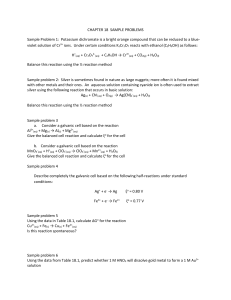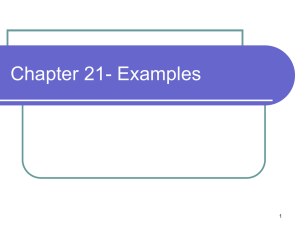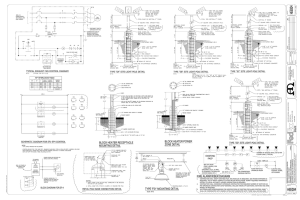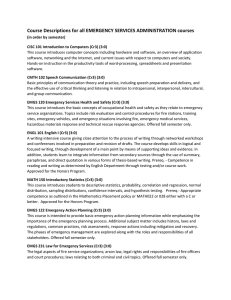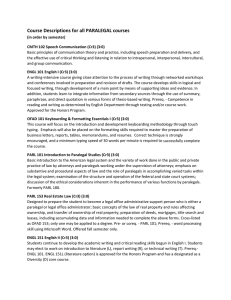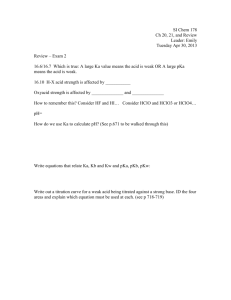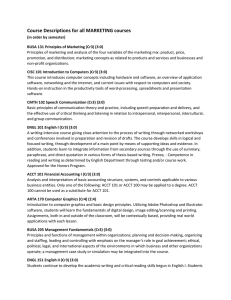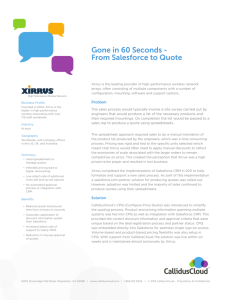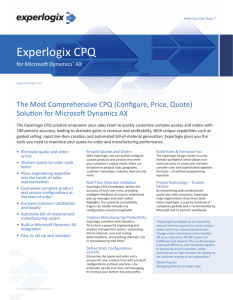مـــــادة ) 1
advertisement
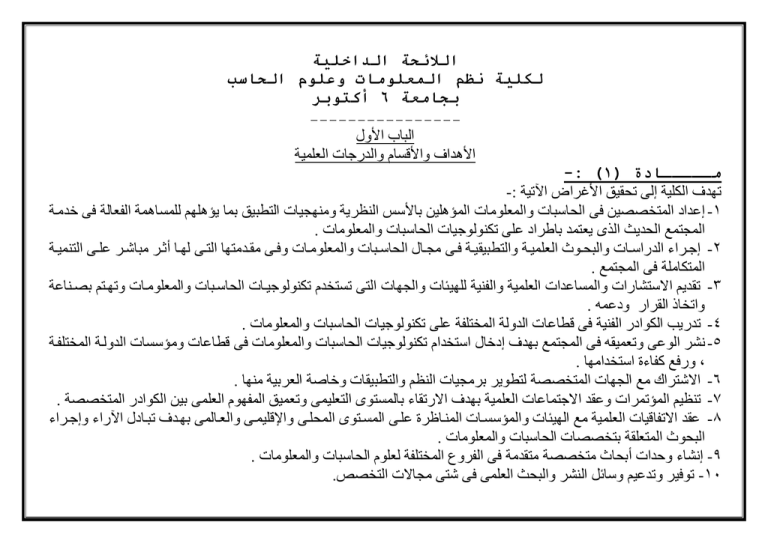
الالئحة الداخلية لكلية نظم المعلومات وعلوم الحاسب بجامعة 6أكتوبر ________________ الباب األول األهداف واألقسام والدرجات العلمية مـــــادة (-: )1 تهدف الكلية إلى تحقيق األغراض اآلتية -: -1إعداد المتخصصين فى الحاسبات والمعلومات المؤهلين باألسس النظرية ومنهجيات التطبيق بما يؤهلهم للمساهمة الفعالة فى خدمةة المجتمع الحديث الذى يعتمد باطراد على تكنولوجيات الحاسبات والمعلومات . -2إجةةراا الدراسةةات والبحةةوم العلميةةة والتطبيقيةةة فةةى مجةةال الحاسةةبات والمعلومةةات وفةةى مقةةدمتها التةةى لهةةا ةةر مبا ةةر علةةى التنميةةة المتكاملة فى المجتمع . -3تقديم االستشارات والمساعدات العلمية والفنية للهيئات والجهات التى تستخدم تكنولوجيةات الحاسةبات والمعلومةات وتهةتم بصةناعة واتخاذ القرار ودعمه . -4تدريب الكوادر الفنية فى قطاعات الدولة المختلفة على تكنولوجيات الحاسبات والمعلومات . -5نشر الوعى وتعميقه فى المجتمع بهدف إدخال استخدام تكنولوجيات الحاسبات والمعلومات فى قطاعات ومؤسسات الدولةة المختلفةة ،ورفع كفااة استخدامها . -6اال تراك مع الجهات المتخصصة لتطوير برمجيات النظم والتطبيقات وخاصة العربية منها . -7تنظيم المؤتمرات وعقد االجتماعات العلمية بهدف االرتقاا بالمستوى التعليمى وتعميق المفهوم العلمى بين الكوادر المتخصصة . -8عقد االتفاقيات العلمية مع الهيئات والمؤسسةات المنةاةرة علةى المسةتوى المحلةى واىقليمةى والعةالمى بهةدف تبةادل اآلراا وإجةراا البحوم المتعلقة بتخصصات الحاسبات والمعلومات . -9إنشاا وحدات بحام متخصصة متقدمة فى الفروع المختلفة لعلوم الحاسبات والمعلومات . -11توفير وتدعيم وسائل النشر والبحث العلمى فى تى مجاالت التخصص. مـــادة ( -: ) 2 تتكون الكلية من األقسام العلمية التالية -: قسم علوم الحاسب -1 قسم نظم المعلومات -2 قسم العلوم األساسية -3 ويجوز ن تنشأ بالكلية قسام خرى وفقا ً ألحكام قانون تنظيم الجامعات الخاصة . مــــادة ( -: ) 3 تمنح جامعة 6كتوبر بناا على طلب مجلس الكلية درجة البكالوريوس وذلك فى حد التخصصات العلمية اآلتية -: (ا) -علـــوم الحاسب (ب) -نظم المعلومات ويجوز ن تمنح الجامعة بناا على طلب مجلس الكلية هذه الدرجات العلمية فى تخصصات خرى وفقا ً ألحكةام قةانون تنظةيم الجامعةات الخاصة . البـــاب الثانــــى درجـــــــة البكــالــوريـــــوس مـــــادة (-: )4 تقبل الكلية خريجى الثانوية العامة عبة علمى رياضة وما يعادلها بمجموع ال يقل عن ،%55كما تقبةل الكليةة طةاب الشةعب األخةرى والدبلومات المتوسطة والثانوية الصناعية والتجارية على ن يجتازوا امتحان قدرات وامتحان معادل للثانوية العامة فى المةواد المؤهلةة والتى يحددها مجلس الكلية لتتوافق مع متطلبات المجلس األعلى للجامعات. مـــــادة (-: )5 يطبق نظام الساعات المعتمدة فى الدراسة وتمنح درجة البكالوريوس بشرط اكتساب 136ساعة على األقل واستيفاا المتطلبةات العامةة ومتطلبات التخصص .ومدة الدراسة النمطية لنيل درجة البكالوريوس ربع سنوات جامعية مقسمة علةى مانيةة فصةول دراسةية نظاميةة باىضافة إلى تدريب عملى .ويمكن للطالب اختصار الفصول و زيادتها والدراسة فى فصةول صةيفية طبقةا ً لنظةام السةاعات المعتمةدة ، على ال تزيد إجمالى مدة الدراسة عن مانى سنوات . مــــادة (-: )6 يمنح الطالب درجة البكالوريوس فى التخصصين التاليين -: علوم الحاسب نظم المعلومات بشرط تحقيق الحد األدنى للساعات المطلوبة لكل تخصص .وتبين الجداول الملحقة بهذه الائحة المقررات الدراسية المقترح توزيعها على فصلين دراسيين نظاميين لكل عام من سنوات الدراسة وعدد الساعات المعتمدة والساعات المخصصة سبوعيا ً لكل مقرر من محاضرات ودروس عملية وتمارين ،ويمكن للطالب التسجيل فى بعض هذه المواد و كثر منها وبحد قصى قدره ا نان وعشرون ساعة حسب نظام الساعات المعتمدة ،ويقر مجلس الكلية بعد خذ ر ى مجالس األقسام المحتوى العلمى لكل مقرر دراسى . مــــادة (-: )7 فى ختام كل فصل دراسى يعقد امتحانات نهاية المقررات التى درست وتضاف نتيجتها إلى نتيجة تقويم عمال الطاب خال الفصل الدراسى ،وتحدد الجداول الملحقة الدرجات المقررة المتحان نهاية المقرر و عمال الفصل لكل مقرر .وتحول النتيجة الكلية لتقديرات وتمنح كل منها نقاط محددة عن كل ساعة معتمدة حسب الجدول التالى -: التقدير A AB+ B B- النقاط لكل ساعة معتمدة 4 3667 النسبة المئوية 91فأكثر 89 - 85 3633 3 2667 84 -82 81 -78 77 -75 التقدير اللفظى ممتاز جيد جداً C+ C CD+ D F I 2633 2 1667 1633 1 1 1 74 -72 71 -68 67 -65 64 -61 59 -51 قل من % 51 جيد مقبول راسب غير مكتمل يعطى التقدير - Iغير مكتمل – فى الحاالت الطارئة الخارجة عن إرادة الطالةب والتةى تحةول بينةه وبةين اسةتكمال دراسةته لمقةرر مةا ، وعليه تأدية االمتحان واستكمال متطلبات المقرر قبل إغاق باب الحذف واىضةافة فةى الفصةل الدراسةى التةالى ،وإن لةم يفعةل ذلةك يةتم تغيير التقدير إلى Fفى هذا المقرر. مــــــادة (-: ) 8 يحسب المعدل الفصلى للطالب على ساس مجموع النقاط التى حصةل عليهةا الطالةب فةى جميةع المقةررات التةى سةجل فيهةا فةى الفصةل الدراسى مقسوم على مجموع الساعات المعتمةدة لهةذه المقةررات .ويحسةب المعةدل التراكمةى للطالةب علةى سةاس مجمةوع النقةاط التةى حصل عليها الطالب فى جميع المقررات التى درسها مقسوم على مجموع الساعات المعتمدة لهذه المقررات. وترصد تقديرات الطالب فى سجله الدراسى فى كل فصل دراسى إلى جانب معدله الفصلى والتراكمى. مــــــادة (-: ) 9 يجوز للطالب إضافة مقررات و االنسحاب من مقررات قبل الموعد المحدد لإلضافة واالنسحاب فى التقةويم الجةامعى بموافقةة المر ةد األكاديمى ،وفى حالة االنسةحاب بعةد الموعةد المحةدد للحةذف يعطةى الطالةب إمةا تقةدير منسةحب كلةى WFعنةد عةدم نجاحةه فةى عمةال الفصل و منسحب جزئى WPعند نجاحه فى عمال الفصل. مـــــادة (-: )11 من حق الطالب إعادة مقرر ما فى حالة حصوله على تقدير D+و Dو ، Fعلى ال تزيةد إجمةالى السةاعات المعتمةدة التةى يعةاد فيهةا المقررات عن 15ساعة وعدد مرات اىعادة فى المقرر الواحد عن مرة واحدة ،وفى هذه الحالة يتم إسقاط التقدير السابق للطالب عنةد حساب معدله .وفى حالة زيادة الساعات و عدد المرات عن المسموح به يدخل التقدير السابق فى حساب معدل الطالب. مـــــادة (-: )11 يوضع الطالب على قائمة اىنذار األكاديمى إذا قل معدله التراكمى عن 1بعد استيفائه 34ساعة معتمدة و إذا قل معدله التراكمةى عةن 1667بعد استيفائه 71ساعة معتمدة وتحديد تخصصه ،ويتم إخطار الطالةب وولةى مةره كتابةة بحالةة اىنةذار ومةا يترتةب عليهةا .وفةى خال فصل اىنذار ال يسمح للتسجيل للطالب فةى كثةر مةن 12سةاعة معتمةدة .وفةى حالةة اسةتمرار الطالةب فةى قائمةة اىنةذار لفصةلين دراسيين متتاليين يتم فصل الطالب و تغيير تخصصه المختار . مـــــادة (-: )12 يحرم الطالب من داا االمتحان التحريةرى ألى مقةرر إن لةم يكةن مسةتوفيا ً نسةبة حضةور ال تقةل عةن ، % 75وفةى هةذه الحالةة يعطةى الطالب تقدير ،Fويجوز ألستاذ المادة التغاضى عن هذا الشرط فى حالة الغياب بعذر. مـــــادة ( -: ) 13 يكلف الطاب المنقولون إلى المستوى الثالث و الرابع بحضور فترة تدريب عملةى لمةدة ةهر علةى األقةل فةى إحةدى الجهةات المتصةلة بتخصصهم .ويحدد مجلس الكلية ماكن التدريب ونظام توزيع الطاب ونظام المتابعة والتقييم . وال تمنح هادة التخرج إال للطاب الذين تموا التدريب العملى بنجاح . مــــادة (-: ) 14 ي قوم طلبة الفرقة النهائية بإعداد مشروع ممتد توزع ساعاته على فصلين دراسيين ،ويجوز فى بعض الحاالت التى يقرها المر د األكاديمى استكمال المشروع فى فصل دراسى واحد .وتحدد مجالس األقسام المختصة موضوعات المشاريع ويحدد مجلس الكلية بناا على اقتراح مجالس األقسام المختصة فترة إضافية للمشروع بعد االمتحان فى نهاية الفصل الدراسى ،وكذلك يقوم بتشكيل لجان تقييم المشاريع عمليا ً و فهيا ً . مــــادة ( -: ) 15 يحسب التقدير العةام للطالةب فةى درجةة البكةالوريوس علةى سةاس معدلةه التراكمةى فةى كةل السةنوات الدراسةية .ويمةنح الطالةب مرتبةة الشرف إذا كان تقديره التراكمى العام 365على األقل. الـ ـف ـصــل الــدراس ــى :األول السنة الدراسية :األولى ال ـت ـخ ـصــص :عــام رقم عدد الساعات الدراسية 13 : النهاية أعمال المقرر إس ـ ــم الـ ـ ـ ـ ـم ـ ـ ـ ــادة املعتمدة نظرى تدريب عملى العظمى الفصل 111 لـغـة إنـجـليزية ()1 English Language I فـيـزيـاء ()1 Physics I ريــاضـيــات ()1 Mathematics I مـقـدمـة عن علوم الـحـاسب Introuction to Computer Science مـقـدمـة عن الـبـرم ـجــة Introduction to Programming أس ــس اإلدارة Fundamentals of Management 111 111 111 111 111 الساعات اإلج ـ ـم ـ ـ ـ ـ ـ ــالــى ال ـس ــاعات الـدراس ـيــة االم ـت ـحـ ــان الــنهــائــى عــملــى ت ـح ـريــرى الدرجة املدة بالساعة الدرجة املدة بالساعة 1 1 1 - 111 11 11 1 - - 1 1 - 1 111 11 11 1 11 1 1 1 1 - 111 11 01 1 - - 1 1 1 1 111 01 01 1 11 1 1 1 1 1 111 01 01 1 11 1 1 1 1 - 111 11 11 1 - - 10 11 0 1 الـ ـف ـصــل الــدراس ــى :الثانى السنة الدراسية :األولى ال ـت ـخ ـصــص :عــام رقم عدد الساعات الدراسية 13 : النهاية أعمال املقرر إس ـ ــم الـ ـ ـ ـ ـم ـ ـ ـ ــادة املعتمدة نظرى تدريب عملى العظمى الفصل 111 لـغـة إنـجـليزية ()1 English Language II فـيـزيـاء ()1 Physics II ريــاضـيــات ()1 Mathematics II نـظـم رق ـم ـيــة Digital Systems الـبـرم ـجــة الـهـيـكـلـيـة Structured Programming ريــاضـة الـمـتـفـردات Discrete Mathematics 111 111 111 111 111 الساعات اإلج ـ ـم ـ ـ ـ ـ ـ ــالــى ال ـس ــاعات الـدراس ـيــة االم ـت ـحـ ــان الــنهــائــى عــملــى ت ـح ـريــرى الدرجة املدة بالساعة الدرجة املدة بالساعة 1 1 1 - 111 11 11 1 - - 1 1 - 1 111 11 11 1 11 1 1 1 1 - 111 11 01 1 - - 1 1 - 1 111 11 11 1 11 1 1 1 - 1 111 11 11 1 11 1 1 1 1 - 111 11 11 1 - - 11 11 0 1 الـ ـف ـصــل الــدراس ــى :األول السنة الدراسية :الـثـانية ال ـت ـخ ـصــص :عــام رقم عدد الساعات الدراسية 82 : النهاية أعمال املقرر إس ــم الـ ـ ـ ـم ـ ـ ـ ــادة املعتمدة نظرى تدريب عملى العظمى الفصل 111 لـغـة إنـجـليزية ()1 English Language III إلـكـتـرونـيـات ()1 Electronics I ريــاضـيــات ()1 Mathematics III الـمـعاجلات الدقيقة Microprocessors هـيـاكل الـبـيـانـات Data Structures أسـس االقـتـصـاد Fundamentals of Economics 111 111 111 111 111 الساعات اإلج ـ ـم ـ ـ ـ ـ ـ ــالــى ال ـس ــاعات الـدراس ـيــة االم ـت ـحـ ــان الــنهــائــى عــملــى ت ـح ـريــرى الدرجة املدة بالساعة الدرجة املدة بالساعة 1 1 1 - 111 11 11 1 - - 1 1 - 1 111 11 11 1 11 1 1 1 1 - 111 11 01 1 - - 1 1 1 1 111 01 01 1 11 1 1 1 1 1 111 01 01 1 11 1 1 1 - - 111 11 11 1 - - 10 11 1 1 الـ ـف ـصــل الــدراس ــى :الـثـانى السنة الدراسية :الـثـانية ال ـت ـخ ـصــص :عــام رقم عدد الساعات الدراسية 82 : النهاية أعمال املقرر إس ـ ــم الـ ـ ـ ـ ـم ـ ـ ـ ــادة املعتمدة نظرى تدريب عملى العظمى الفصل 111 لـغـة إنـجـليزية ()1 English Language IV إلـكـتـرونـيـات ()1 Electronics II ريــاضـيــات ()1 Mathematics IV لـغـة الـتجمـيـع Assembly Language نـظـم إدارة قـواعـد الـبـيـانـات Database Management Systems سـلـوكـيـات الـتـنـظـيم Organizational Behavior 111 111 111 111 111 الساعات اإلج ـ ـم ـ ـ ـ ـ ـ ــالــى ال ـس ــاعات الـدراس ـيــة االم ـت ـحـ ــان الــنهــائــى عــملــى ت ـح ـريــرى الدرجة املدة بالساعة الدرجة املدة بالساعة 1 1 1 - 111 11 11 1 - - 1 1 - 1 111 11 11 1 11 1 1 1 1 - 111 11 01 1 - - 1 1 1 1 111 01 01 1 11 1 1 1 1 1 111 01 01 1 11 1 1 1 - - 111 11 11 1 - - 10 11 1 1 الـ ـف ـصــل الــدراس ــى :األول السنة الدراسية :الـثـالـثـة ال ـت ـخ ـصــص :عــلوم حاسب رقم عدد الساعات الدراسية 82 : النهاية أعمال املقرر إس ـ ــم الـ ـ ـ ـ ـم ـ ـ ـ ــادة املعتمدة نظرى تدريب عملى العظمى الفصل 111 إحـتـمـالت وإحـصـاء Probability and Statistics بـن ــاء الـحــاسب Computer Architecture شـبـكـات االتـصــاالت Communication Networks هـنـدسـة الـبـرمـجـيــات Software Engineering إخـتـيـارى عـلـوم حـاسـب ()1 Computer Science Elective I الـمـحـاسبة وحسابات التكاليف Accounting and Cost Accounting 111 111 111ح 111ح 111 الساعات اإلج ـ ـم ـ ـ ـ ـ ـ ــالــى ال ـس ــاعات الـدراس ـيــة االم ـت ـحـ ــان الــنهــائــى عــملــى ت ـح ـريــرى الدرجة املدة بالساعة الدرجة املدة بالساعة 1 1 1 - 111 11 01 1 - - 1 1 1 - 111 11 01 1 - - 1 1 1 - 111 11 01 1 - - 1 1 1 1 111 11 01 1 11 1 1 1 1 - 111 11 01 1 - - 1 1 - - 111 11 11 1 - - 10 10 0 1 - Computer Arabization Computer Science Elective I: - Formal Languages and Automata - Object Oriented Programming الـ ـف ـصــل الــدراس ــى :الـثـانى السنة الدراسية :الـثـالثة ال ـت ـخ ـصــص :عــلوم حاسب رقم عدد الساعات الدراسية 82 : النهاية أعمال املقرر إس ــم ال ـ ـ ـم ـ ـ ـ ــادة املعتمدة نظرى تدريب عملى العظمى الفصل 111 بـحـوث عـمـلـيـات ()1 Operations Research I نـظـم الـتـشـغـيـل Operating Systems الـخ ـ ـوارزمـيــات Algorithms الـرسـم بالـحـاسب Computer Graphics إخـتـيـارى عـلـوم حـاسـب ()1 Computer Science Elective II دراســات الـجـدوى Feasibility Studies 111 111ح 111ح 111ح 111 ال ـس ــاعات الـدراس ـيــة الساعات االم ـت ـحـ ــان الــنهــائــى عــملــى ت ـح ـريــرى الدرجة املدة بالساعة الدرجة املدة بالساعة 1 1 1 - 111 11 01 1 - - 1 1 1 - 111 11 01 1 - - 1 1 1 1 111 11 01 1 11 1 1 1 1 1 111 11 01 1 11 1 1 1 1 - 111 11 01 1 - - 1 1 - - 111 11 11 1 - - 10 0 1 اإلج ـ ـم ـ ـ ـ ـ ـ ــالــى - Local Area Networks 10 Computer Science Elective II: - Computer Interfaces and Peripherals - Computers in Industry السنة الدراسية :الـرابعة الـ ـف ـصــل الــدراس ــى :األول ال ـت ـخ ـصــص :عــلوم حاسب رقم عدد الساعات الدراسية 82 : النهاية أعمال املقرر إسـ ــم الـ ـ ـم ـ ـ ـ ــادة املعتمدة نظرى تدريب عملى العظمى الفصل 111 نـظـم الـحـاسـبـات الـمـوزعة Distributed Computer Systems هـنـدسـة بـرمـجـيـات مـتـقـدمة Advanced Software Engineering ذكــاء اصـطـنـاعى Artificial Intelligence إخـتـيـارى عـلـوم حـاسـب ()1 Computer Science Elective III الـمـشروع Project مـهـارات االتـص ــال Communication Skills 111ح 111ح 111ح 111 111 الساعات اإلج ـ ـم ـ ـ ـ ـ ـ ــالــى ال ـس ــاعات الـدراس ـيــة االم ـت ـحـ ــان الــنهــائــى عــملــى ت ـح ـريــرى الدرجة املدة بالساعة الدرجة املدة بالساعة 1 1 1 - 111 11 01 1 - - 1 1 1 1 111 11 01 1 11 1 1 1 1 1 111 11 01 1 11 1 1 1 1 - 111 11 01 1 - - 1 1 1 - 01 01 - - - - 1 1 - - 111 11 11 1 - - 11 11 11 1 - Image Processing Computer Science Elective III: - Software Project Management - Advanced Operating Systems الـ ـف ـصــل الــدراس ــى :الـثـانى السنة الدراسية :الـرابعة ال ـت ـخ ـصــص :عــلوم حاسب رقم عدد الساعات الدراسية 82 : النهاية أعمال املقرر إسـ ــم ال ـ ـ ـم ـ ـ ـ ــادة املعتمدة نظرى تدريب عملى العظمى الفصل 111 أمــان الـحـاسـبـات Computer Security نـظم األوساط الـمـتـعددة Multimedia Systems نـظم قواعد بيانات مـتـقـدمة Advanced Database Systems إخـتـيـارى عـلـوم حـاسـب ()1 Computer Science Elective IV الـمـشروع Project التسويق والبيع Marketting and Selling 111 111ح 111ح 111 111 الساعات اإلج ـ ـم ـ ـ ـ ـ ـ ــالــى ال ـس ــاعات الـدراس ـيــة االم ـت ـحـ ــان الــنهــائــى عــملــى ت ـح ـريــرى الدرجة املدة بالساعة الدرجة املدة بالساعة 1 1 1 - 111 11 01 1 - - 1 1 1 1 111 11 01 1 11 1 1 1 1 1 111 11 01 1 11 1 1 1 1 - 111 11 01 1 - - 1 1 1 - 111 01 - - *11 - 1 1 - - 111 11 11 1 - - 11 11 11 1 - Compiler Theory Computer Science Elective IV: - Expert Systems - Neural Networks السنة الدراسية :الـثـالـثـة الـ ـف ـصــل الــدراس ــى :األول ال ـت ـخ ـصــص :نـظم معلومات رقم عدد الساعات الدراسية 82 : النهاية أعمال املقرر إس ــم الـ ـ ـ ـم ـ ـ ـ ــادة املعتمدة نظرى تدريب عملى العظمى الفصل 111 إحـتـمـالت وإحـصـاء Probability and Statistics بـن ــاء الـحــاسب Computer Architecture شـبـكـات االتـصــاالت Communication Networks تـحـ ـل ـيــل ال ـن ـظـم System Analysis إخـتـيـارى نظم معلومات ()1 Information Systems Elective I الـمـحـاسبة وحسابات التكاليف Accounting and Cost Accounting 111 111 111م 111م 111 الساعات اإلج ـ ـم ـ ـ ـ ـ ـ ــالــى ال ـس ــاعات الـدراس ـيــة االم ـت ـحـ ــان الــنهــائــى عــملــى ت ـح ـريــرى الدرجة املدة بالساعة الدرجة املدة بالساعة 1 1 1 - 111 11 01 1 - - 1 1 1 - 111 11 01 1 - - 1 1 1 - 111 11 01 1 - - 1 1 1 1 111 11 01 1 11 1 1 1 1 - 111 11 01 1 - - 1 1 - - 111 11 11 1 - - 10 10 0 1 - Project Management - Computer Arabization - Library Information Systems Information Systems Elective I: الـ ـف ـصــل الــدراس ــى :الـثـانى السنة الدراسية :الـثـالثة عدد الساعات الدراسية 82 : ال ـت ـخ ـصــص :نـظـم معلومات النهاية أعمال رقم املقرر إس ـ ــم الـ ـ ـ ـ ـم ـ ـ ـ ــادة املعتمدة نظرى تدريب عملى العظمى الفصل 111 بـحـوث عـمـلـيـات ()1 Operations Research I نـظـم الـتـشـغـيـل Operating Systems تـصـمـيـم الـنـظـم System Design نـظم املـعـلومات Information Systems إخـتـيـارى نـظـم مـعـلومات ()1 Information Systems Elective II دراســات الـجـدوى Feasibility Studies 111 111م 111م 111م 111 الساعات اإلج ـ ـم ـ ـ ـ ـ ـ ــالــى ال ـس ــاعات الـدراس ـيــة االم ـت ـحـ ــان الــنهــائــى عــملــى ت ـح ـريــرى الدرجة املدة بالساعة الدرجة املدة بالساعة 1 1 1 - 111 11 01 1 - - 1 1 1 - 111 11 01 1 - - 1 1 1 1 111 11 01 1 11 1 1 1 1 - 111 11 01 1 - - 1 1 1 - 111 11 01 1 - - 1 1 - - 111 11 11 1 - - 10 10 0 1 - Office Automation - Computer Graphics - Local Area Networks Information Systems Elective I: الـ ـف ـصــل الــدراس ــى :األول السنة الدراسية :الـرابعة ال ـت ـخ ـصــص :نـظـم معلومات رقم عدد الساعات الدراسية 82 : النهاية أعمال املقرر إس ــم الـ ـ ـ ـم ـ ـ ـ ــادة املعتمدة نظرى تدريب عملى العظمى الفصل 111 نـظـم الـحـاسـبـات الـمـوزعة Distributed Computer Systems نـمـذجــة ومـح ــاكــاة Modeling and Simulation بـحـوث عـمـلـيـات ()1 Operations Research II إخـتـيـارى نـظـم مـعـلومات ()1 Information Systems Elective III الـمـشروع Project مـهـارات االتـص ــال Communication Skills 111م 111م 111م 111 111 الساعات اإلج ـ ـم ـ ـ ـ ـ ـ ــالــى - Geographical Information Systems ال ـس ــاعات الـدراس ـيــة االم ـت ـحـ ــان الــنهــائــى عــملــى ت ـح ـريــرى الدرجة املدة بالساعة الدرجة املدة بالساعة 1 1 1 - 111 11 01 1 - - 1 1 1 1 111 11 01 1 11 1 1 1 1 - 111 11 01 1 - - 1 1 1 - 111 11 01 1 - - 1 1 1 - 01 01 - - - - 1 1 - - 111 11 11 1 - - 11 11 11 1 - Distributed Computer Systems - Artificial Intelligence Information Systems Elective I: الـ ـف ـصــل الــدراس ــى :الـثـانى السنة الدراسية :الـرابعة ال ـت ـخ ـصــص :نـظـم معلومات رقم عدد الساعات الدراسية 82 : النهاية أعمال املقرر إس ــم الـ ـ ـ ـم ـ ـ ـ ــادة املعتمدة نظرى تدريب عملى العظمى الفصل 111 أمــان الـحـاسـبـات Computer Security نـظم األوساط الـمـتـعددة Multimedia Systems نـظـم دعم ال ـقـ ـرار Decision Support Systems إخـتـيـارى نـظـم مـعـلومات ()1 Information Systems Elective IV الـمـشروع Project التسويق والبيع Marketting and Selling 111 111م 111م 111 111 الساعات اإلج ـ ـم ـ ـ ـ ـ ـ ــالــى - Advanced Database Systems * درجة االمتحان الشفوى للمشروع كـمـادة موحدة ال ـس ــاعات الـدراس ـيــة االم ـت ـحـ ــان الــنهــائــى عــملــى ت ـح ـريــرى الدرجة املدة بالساعة الدرجة املدة بالساعة 1 1 1 - 111 11 01 1 - - 1 1 1 1 111 11 01 1 11 1 1 1 1 1 111 11 01 1 11 1 1 1 1 - 111 11 01 1 - - 1 1 1 - 111 01 - - *11 - 1 1 - - 111 11 11 1 - - 11 10 0 1 - Management Information Systems - Expert Systems Information Systems Elective I: Course Contents 111-English Language I Cr2 To go through all computer expressions and terms contained in an abbreviated computer dictionary. Articles - nouns - adjectives - Kinds of pronouns - interrogative adjectives, pronouns and adverbs possessive adjectives , personal and other pronouns - relative pronouns and relative clauses. 112-Physics ICr3 Direct current circuits: charge, current, voltage, power, Ohm’s low, resistors and their combinations, mesh and node analysis. Alternating current circuits: average and effective value, phase angle, power, inductors and capacitors. The laboratory includes introduction to the measuring instruments: Ammeters, Voltmeters and Oscilloscopes and their use in circuit measurements. 113-Mathematics I Cr3 Functions: range, domain, graphs, limits and continuity - Exponential and logarithmic functions Trigonometric functions - Differentiation: rules of differentiation, higher order derivatives - Applications of differentiation: maxima and minima, curve sketching. 114-Introduction to Computer ScienceCr3 Machine architecture - The human/machine interface: operating systems, algorithms, programming languages, software engineering - Data organization: data structures, File structures, Database structures Artificial intelligence - Theory of computing. Computer Applications. 115-Introduction to Cr4 Programming Software engineering concepts and software life cycle - Operating system functions - Basic program control structures - Algorithms and flowcharts -Computer memory organization - Compilation and linking - Introduction to program structure and syntax using PASCAL - Data types and ranges - PASCAL operators - Simple I/O - Loop control structures - Arrays - Procedures and functions. 116-Fundamentals of Cr2 Management Management and managerial environment - Levels and types of management - Managing work and organizations - Managing people in organization - Managing production and operations - Decision making. 211-English Language Cr2 III Main elements of writing reports - essays - summaries - abstracts - Writing reports on computer organizations - computer centers - information centers - Writing summaries - abstracts of research papers / reports. 212-Electronics ICr3 Bipolar transistors - Field effect transistors - MOS transistors - Operational amplifiers - Logic gates . 213-Mathematics Cr3 III Ordinary differential equations: first and second order linear differential equations with constant coefficients. Numerical solutions of differential equation. 214-MicroprocessorsCr4 Microprocessors and microcomputers - Microcomputers structure - Microprocessors architecture - I/O interface adapters - Memory - Interrupts - Direct memory access - Debugging aids . 215-Data Structures Cr4 Stacks: implementation and applications. Queues: implementation and applications. Linked lists, linked stacks and linked queues. Tree structures, tree search and tree traversals. 216-Fundamentals of Economics Cr2 Economic systems - Financial management - Economics and Financing of data processing centers. 311-Probabilities and Statistics Cr3 Probability as a mathematical system - Random variables and their distribution - Limit theorems Statistical inference . 312-Computer Architecture Cr3 Implementation of large memory systems - Cache memory - Virtual memory - Bussing systems - Control - DMA - I/O control methods - Interrupts - Synchronization - Alternative architectures: CISC and RISC. 313-Communication Networks Cr3 Network architecture - Network elements - Data link - Communication protocols - Switching and Routing - End-To-End protocols - LAN - WAN - Data security. C314-Software Engineering Cr3 The Software development process - Software requirements and specifications: Informal and Formal specifications - Software design and implementation: Functional/Process oriented design, Implementation strategies - Verification and Validation. I314 System Analysis Cr3 Fundamental concepts, system definition, user definition, the different types of users, communication gap, system analyst, system management, structure system analysis, system analysis tools data flow diagram (DFD), data dictionary, English structure, decision tables, decision trees. The system life cycle, problem definition and modules, feasibility studies. Source and destination of data, stores, development plan, analysis phase, IPO chart, generating alternatives. Design methods, automation boundary, alternative implementations, system flow chart, system components, cost/benefit analysis, implementation schedule, physical elements, programs, files, manual procedure and training, forms. Analysts recommendation, logic of the process, detailed design, identifying options, system control program, screens, reports and files, test plan, implementation and maintenance. * C315-Computer Science Elective I: * Formal Languages and Automata Cr3 Finite automata and regular expressions – Context-free grammars and push-down automata – Classification of programming engineering – Graphical representation – Fourth generation languages – Object oriented programming – Query languages, report generators & application generators. * Computer Arabization Cr3 Benefits of Arabization - Different types of Arabization - Arabic standard codes - Arabic user interface Arabization of operating systems - Arabization of applications - Arabic dictionary. * Object Oriented Programming Cr3 Objects and object classes - Object oriented design - Functional oriented design: data flow diagrams and structure charts - Concurrent systems design - User interface design *I315 Information Systems Elective I: *Computer Arabization Cr3 Introduction: Arabization needs, advantages and disadvantages of Arabization, firmware Arabization, different types of Arabization, context analyzer, Arabic standard codes, Arabic user interface (Screen, printer, fonts,...etc.), comparison of Arabic text, Arabization of operating systems, Arabization of application packages, AI and Arabization, Arabic computational linguistics, Arabic OCRC (algorithms and implementation), Arabic dictionary, automatic translation. *Project Management Cr3 Design quality assurance: Design reviews, user interface evaluation. Programming practice: Program development, programming style, error handling, data abstraction. Portability and reuse of software: portability, machine architecture dependencies, operating system dependencies, software reuse. Computer aided software engineering “CASE”. Software environment: CASE workbenches, textediting systems, language processing systems. Program verification and validation: The test process, top-down and bottom, up testing, test planning and scheduling, program debugging. Testing techniques: Equivalence partitioning, static program verification, testing and debugging tools. Software management: Project planning & scheduling, project milestones, option analysis, software-cost estimation. Software maintenance: Maintenance costs, measuring program maintainability, system restructuring, configuration management. Documentation & software quality assurance: User documentation quality, documentation tools, documentation maintenance. *Library Information Systems Cr3 Automating Library’s activities: Providing libraries with their materials, paying invoices of dealers and publishers, stock registers, holdings; Cataloging, mark classification, CDS-ISIS, Windows, VTLS, DOBIS LIPIS and others. Circulation, selection and dissemination of information: Bibliographic services, references services. 316-Accounting and Cost Accounting Cr2 Overview of transaction processing systems and their implementation for application, e.g., airline reservations, banking, and inventory control. Evolution and history of transaction processing systems. Review of fault tolerance, processing monitors and their implementation, lock managers, recovery managers, file management and access paths, and disaster recovery and data replication. Information retrieval systems. Survey of commercial systems and research prototypes. 411-Distributed Computer Systems Cr3 Concepts of distributed computer systems architecture and programming, with emphasis on client/server computing - Models of parallel architecture - parallel algorithms. C412-Advanced Software Engineering Cr3 Algebraic specifications for abstract data types - Performance improvement, debugging, antibugging Using pre- and postconditions, invariants, elementary proof of correctness - Structured walkthroughs – Testing I412-Modeling and Simulation Cr3 Modeling - Properties of linear models - Simulation methodology - Generation of random variables Parameter estimation - Design of experiment . C413-Artificial Intelligence Cr3 Introduction to artificial intelligence - Understanding natural Languages - AI architecture - knowledge representation - Machine learning - Object oriented knowledge representation. I413-Operations Research II Cr3 Integer programming - Project scheduling by PERT-CPM - Dynamic programming - Stochastic models Forecasting - Queuing models - Inventory systems - Markov processes. * C414-Computer Science Elective III * Software Project Management Cr3 Standards - Organization - Project control standards - Project-team standards - Documentation implementation . * Image Processing Cr3 Image representation - Spatial domain processing: differentiation and smoothing, template matching, region analysis, contour following - Line and shape description - Perspective transformations - Hardware and software considerations. * Advanced Operating Systems Cr3 Device management - File systems and naming - Security and protection - Communications and networking - Distributed and real-time systems. * I414-Information Systems Elective III: * Geographical Information Systems Cr3 Representation of geographic data - Relationships of graphic and nongraphic data - Data collection Vector digitizing and raster data - Attribute data - Graphic data storage - Planimetric, topographic and cadastral features - Annotation - Components of GIS – Applications *Distibuted Computer Systems Cr3 Introduction to parallel and distributed architectures. Models of computation: SISD, SIMD, MISD, and MIMD Computers. Shared-memory SIMD computers. Interconnection-network SIMD Computers: Linear array, two-dimensional array, tree connection, perfect shuffle connection, cube connection. Analyzing algorithms. Some parallel computer algorithms: selection, merging, sorting and searching. Parallel programming languages. Parallel compilers. Parallel operating systems. *Artificial Intelligence Cr3 Artificial and Human intelligence: Domains of AI-symbolic processing: Semantic nets, modeling, model based reasoning, frames. Inference techniques: Implication, forward and backward chaining, inference nets, predicate logic, quantifiers, tautology, resolution, and unification. Rule based systems: Inference engine, production systems, problem solving, planning, decomposition, and basic search techniques. AI languages: Symbolic and coupled processing prolog: Objects and relations, compound goals, backtracking, search mechanism, dynamic databases, Lisp: program structure and operations, functions, unification, memory models. Fields of AI: heuristics and game playing, automated reasoning, problem solving, computational linguistics and natural language processing, computer vision, robotics. AI based computer systems: Sequential and parallel inference machines, relation between AI and artificial neural nets, fuzzy systems. 415-Project Cr2 Students are allowed to choose among a number of projects suggested by the different staff members. The general aim of the project is to allow each student to integrate all the disciplines he has studied in a unified chunk of knowledge. On the behavioral side, students are allowed to work in a team so as to practice working in a collaborative environment. This emphasizes also a proper documentation and presentation procedure. 416-Communication Skills Cr2 Perception, learning, motivation and value; individual differences and work performance; understanding yourself; motivating yourself and others, working within groups, achieving success through goal setting, achieving high personal productivity and quality; achieving rewarding and satisfying career; communicating with people; leading and influencing others; building relationships with supervisors, co-workers and customers. 121-English Language ICr2 Adverbs - prepositions - conjunctions - verbs - auxiliary verbs - may - can - must - have to - need - dare ought - used - Purpose clauses - Expressing preferences - Making comparisons - Conditional statements Reported statements. 122-Physics II Cr3 Electrostatics: charge, field and potential - Electromagnetics: magnetic field and its relation to electric current - Applications: the cathode-ray tube. Conduction in solids - Semiconductors: p- and n-type materials - The p-n junction diode - Diode circuits. 123-Mathematics IICr3 Integration: definite and infinite integrals - Methods of integration: integration by substitution, integration by parts, partial fractions, the trapezoidal and Simpson’s rule - Applications of integration. 124-Digital Systems Cr3 Basic logic elements - Combinational logic circuits - Data representation - Sequential logic elements Registers - Counters - Memory. 125-Structured Programming Cr4 Structured programming concepts - Debugging, testing and verifying - String processing - Internal searching and sorting - Data structures - File processing - Recursions . 126-Discrete MathematicsCr2 Propositions - Truth and consequences - Sets and numbers - Counting and combinatorics - Predicate calculus - Proof – Relations 221-English Language IV Cr2 Emphasis on oral presentation of selected topics in information systems. 222-Electronics II Integrated circuits technology - Logic families: TTL family ,CMOS family - LSI and VLSI circuits Programmed logic - Microptocessor support chips - Peripheral interfacing - Analog interfacing. 223-Mathematics IV Cr3 Solutions of linear systems of equations: Gaussian Elimination - Vectors and Matrices - Vector spaces Linear transformation - Products - Eigenvalues and Canonical form. 224-Assembly Language Cr4 Review of computer architecture - Assembly language - Addressing techniques - Macros - File I/O Program segmentation and linkage . 225-Database Management Systems Cr4 Review of basic concepts - Functions and components of DBMSs - Environment - Database generation s - Interrogation - Update - Data model - Security policies - Major trade-offs in DBM . 226-Organizational Behavior Cr2 An introduction to group psychology and psychology of organizations. 321-Operations Research I Cr3 The nature of operations research - Allocation Problems - Inventory problems - Replacement, maintenance and reliability problems - Linear programming - Sequencing and co-ordination 322-Operating Systems Cr3 Review of batch process - system program - Processes Parallelism in operating systems - Mutual exclusion - Synchronization - Switching control and traffic control - System deadlocks - Scheduling and dispatch - Physical and virtual memory organization C323-Algorithms Cr3 Analysis and complexity of algorithms - Design methods: Divide and Conquer, Greedy method Dynamic programming - Backtracking - NP-hard and NP-complete problems. I323-System Design Cr3 Objectives of system design - Design methods - Alternative implementations - Outputs of system design: system flow chart, list of system components, cost/benefit analysis, implementation schedule - Physical elements of system design - Detailed design - Testing - Maintenance. C324-Computer Graphics Cr3 Drawing elementary figures - Graphics fundamentals: Display screen viewing, Windowing, Clipping, Color - Elementary shading techniques - Two-Dimensional geometric transformation - Display file segmentation - Interactive graphics - Three-Dimensional graphics. I324-Information Systems Cr3 Objectives of information systems - Computer based information systems (CBIS) - Data processing systems - Transactions processing systems - Impact of CBIS on management - The organization of data CBIS and decision making * C325-Computer Science Elective II: * Computer Interfaces and Peripherals Cr3 Input devices - Output display devices - Output hard-copy devices - Mass storage devices - Multimedia and virtual reality devices. * Local Area Networks Cr3 Network structure and topology - Access techniques - Network traffic - Performance of basic access protocols - Polling and random access - Standards for LANs. * -Computers in Industry Cr3 Organization of industrial information and control systems - Control computers and real-time requirements - Operator interfaces and supervisory control - Industrial communication networks. * I325-Information Systems Elective II: * Office Automation Cr3 Concepts and importance of office work - Role and goal of automated offices - Recent requirements for office automation - Classification and indexing - Word processing systems - Graphics presentation systems - Electronic mail - Teleconferencing. * Computer Graphics Cr3 Introduction to computer graphics: History, applications, and graphics system software. Output primitives: Points, lines, circles, ellipses, character generation. Attributes of output primitives: Color and intensity, area filling, character attributes. Two-dimensional transformations: Basic transformations; translation, scaling and rotation. Matrix representations and homogeneous coordinates, Composite transformations. Windowing and clipping. Segments. Interactive input devices. *Local Area Networks Cr3 Web technologies: Server-side programs, common gateway interface (CGI) programs, client-side scripts, the applet concept. Characteristics of web servers: Handling permissions, file management, capabilities of common server architectures. Role of client computers. Nature of the clientserver relationship. Web protocols .Support tools for web site creation and web management. Developing Internet information servers. Publishing information and applications. Protocols at the application layer Principles of web engineering. Database-driven web sites. Remote procedure calls (RPC).Lightweight distributed objects. The role of middleware. Security issues in distributed object systems. Enterprise-wide web-based applications. Overview of the history, evolution, and compatibility of wireless standards. The special problems of wireless and mobile computing. Wireless local area networks and satellite-based networks. Wireless local loops. Mobile Internet protocol. Extending the client-server model to accommodate mobility. Mobile data access: server data dissemination and client cache management. Software package support for mobile and wireless computing. The role of middleware and support tools .Performance issues. Emerging technologies. 326-Feasibility Studies Cr3 Economical feasibility studies - Marketing feasibility studies - Legal and Environmental feasibility studies - Technical feasibility studies - Social and National feasibility studies. 421-Computer Security Cr3 Security risks and protection issues in data-processing systems - construction of cryptosystems - Analysis of cryptosystems - Public-key systems - Data encryption standard - Viruses and worms - Authentication in data-processing systems . 422-Multimedia Systems Cr3 Introduction and definition - Network architecture for multimedia - Video compression and processing voice processing - Human computer interaction -Case studies . C423-Advanced Database Systems Cr3 Advanced features of relational model - Normalization - Database design: information level, physical level - Distributed database systems: database computers, object oriented systems, knowledge-based systems - Database processing in LAN’s. I423-Decision Support Systems Cr3 System components , characteristics , uses , advantages - Importance of DSS to managers - Tools for building the system - Procedures to build the models & using them for optimum solution - Examples * C424-Computer Science Elective IV: * Expert Systems Cr3 Knowledge-based expert systems - Human problem solving - Representation of knowledge - Drawing inferences - Languages and tools - Knowledge engineering tools - Applications. * Compiler Theory Cr3 Translating regular expressions to finite automata - Grammars and parsing - Semantic processing Symbol tables - Run-time storage organization - Declaration processing - Procedures and functions Code generation and optimization. * Neural Networks Cr3 Neural network concepts - Learning laws - Associative networks - Mapping networks - The backpropagation neural network - Self-organizing maps - Packages for neural network applications. * I424-Information Systems Elective IV: * Management information systems Cr3 Objectives of MIS - The managerial activities - Management information characteristics - MIS functions and components - Transaction processing -On-line systems -System life cycle - Data preparation cycle Data verification techniques - System Access and response - Data security and privacy - Functional applications of MIS *Advanced Database Systems Levels of distribution transparency. Distributed database design, mapping users transactions to distributed level. Optimization of accesses strategies. The management of distributed transaction. Distributed concurrence control, recovery in distributed database. Distributed database administration. Commercial systems. The SDD I system. Data mining: Associative and sequential patterns. Data clustering. Market basket analysis. Data cleaning. Data visualization. Information storage and retrieval : Characters, strings, coding, text. Documents, electronic publishing, markup, and markup languages. Tries, inverted files, PAT trees, signature files, indexing. Morphological analysis, stemming, phrases, stop lists. Term frequency distributions, uncertainty, fuzziness, weighting. Vector space, probabilistic, logical, and advanced models. Information needs, relevance, evaluation, effectiveness. Thesauri, ontologies, classification and categorization, metadata. Bibliographic information, bibliometrics , citations. Routing and (community) filtering. Search and search strategy, information seeking behavior, user modeling, feedback. Information summarization and visualization. Integration of citation, keyword, classification scheme, and other terms. Protocols and systems (including Z39.50, OPACs, WWW engines, research systems) *Expert Systems Cr3 Introduction: Knowledge based expert systems, conventional programming versus knowledge engineering. Human problem solving: Human information processing, the production system as a processing model, problem solving, varieties of knowledge, and the nature of expertise. Representation of knowledge: An informal look at a knowledge base, strategies for representing knowledge, semantic networks, object attribute value triplets, rules, frames. Representing facts and relationships using logic. Drawing inferences; Inferences control, the future of representation and inference. Languages and tools: Levels of software, the languages tool continuum, AI languages and environments, knowledge engineering tools. Expert shells. Building a mall knowledge system: The role of small systems, selection of an appropriate problem, development of a prototype system. 425-Project Cr2 Students are allowed to choose among a number of projects suggested by the different staff members. The general aim of the project is to allow each student to integrate all the disciplines he has studied in a unified chunk of knowledge. On the behavioral side, students are allowed to work in a team so as to practice working in a collaborative environment. This emphasizes also a proper documentation and presentation procedure. 426-Marketting and Selling Cr2 The course concentrates on recognizing and explaining business processes and identifying and recommending Internet/E-Commerce opportunities that can enhance service quality and cost effectiveness topics include challenges, opportunities, internet service Providers, Intranets, Extranets, marketing concepts in the context of the internet, basics of marketing a site on the Net, electronic purchasing and shopping models using search engines, understanding what e-customers want and the key points to satisfy them, Webcopyright issuers, ethic markets, Growth of business to business
